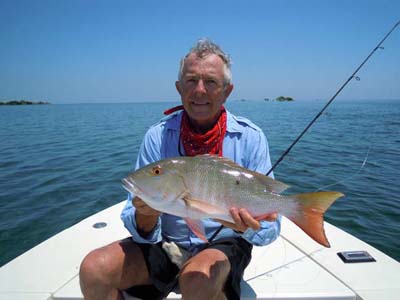
Will this behemoth take a 6-inch orange streamer fly? Yes it will. Smithsonian got it wrong saying: “Because of its size, it is not likely?” Smithsonian Magazine.com. (Wikimedia Commons)
Piscivores, like sharks, are the fiercest animals in saltwater, and along with being both exhilarating and dangerous, they are now, thanks to old-timey Keys fly anglers, quite catchable on a fly
By Skip Clement
Thanks to the guides in the Florida Keys, sharks eventually attracted the attention of more clients and got written about in the best fishing magazines of the day. That opened up a whole cast of anglers on both coasts fishing for sharks in the most shameful way, kill for the boast of it, and then into the dock dumpster and teeth for sale at novelty shops.
Guide John Emery, nicknamed Little John by his friends, along with ofttimes angling companion Norman Duncan (inventor of the Uni-Knot), initiated the earliest savvy of fishing for sharks and approached it as a sport – catch and release. They unlocked the earliest secret of how to attract their attention with a fly. Here is how that all happened . . .

Norman Duncan today with a Biscayne Bay mutton snapper. Duncan image.
Norman Duncan recalls the 1950s
“John and I would fish the roadside flats, and the canals in new housing developments of the Upper Florida Keys, then head back early in the afternoon. We would stop roadside just north of the Jewfish Creek Bridge [then a narrow one lane draw bridge spanning the creek] along Barnes Sound. At that time, there was a fish house on pilings out in the Barnes Sound called “Manatee Smoked Fish,” they also sold fresh fish and turtle meat. We found that they slaughtered the turtles and fish then at night then threw the carcasses out the back door into the sound. Even driving by, we could see the small bonnet and lemon sharks cruising these beautiful white sandy flats. We would find out when they were going to dump a load of fish and turtle waste.
While fishing the canals and channels, we often used the orange/yellow streamer fly that had been recently developed for tarpon by Kay Brodney and Jim Adams. They were both steelhead and Pacific salmon anglers from the Northwest [Kay still holds several IGFA world records]. Brodney’s accomplishments can be found in Steve Kantner’s book, [Fifty Women Who Fish].
Usually, we tied a shock leader on the tippet, sometimes with wire. If we didn’t re-rig, we would use some of these same flies when we waded these flats. We soon found that the sharks and barracudas would respond best to the orange/red flies, we thought that these colors best imitated the carnage that they were feeding on from the smokehouse.
At about this time, I read a report that the US Navy had tested several different life rafts out in the ocean by dropping them all well offshore. When they came back a week later, they found that the rafts from one of the manufacturers had one side ripped apart apparently by sharks. It turned out that this manufacture had their specifications written on an orange patch at the waterline! John and I were not at all surprised at this finding.
By the early 1960’s Little John and I joined some of the local fishing clubs, the members were keen on learning as much as they could about all aspects of light tackle fishing. When the subject of how to get the generally nearsighted sharks to respond to a fly, we recommended using orange/red streamer flies since we had found them to be most effective.
This concept of fly colors took off in the fly fishing circles. However, I don’t know for sure if Kay Brodney’s, Little John, and my idea was the first introduction of streamer fly pattern and color to attract shark and barracuda, but it is still the gold standard worldwide today.”
NOTE 1. Emery past away soon after the period Duncan refers to from the ravages of a life on the water without sunscreen protection – skin cancer.
NOTE 2. Sharks continually shed their teeth; some Carcharhiniformes shed approximately 35,000 teeth in a lifetime.
NOTE 3. How to tie the Duncan Loop Knot correctly.

Tropical Atlantic waters of Dry Tortugas National Park in the Florida Keys. NPS photo.






